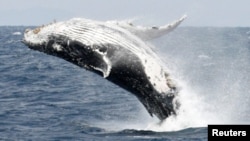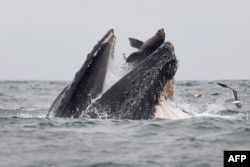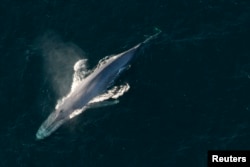Scientists have wondered long on the mystery of how whales got so big. A new study suggests some answers.
Whales are ocean animals. The fin, bowhead, gray, humpback and sperm whales are the largest animals living today. In fact, the blue whale is the largest animal known to have ever existed, bigger than any dinosaur.
The recent study by researchers in Brazil found that four genes appear to play a big part in whales’ huge size, a condition known as gigantism. The researchers said the four genes appear to have produced great size while easing the problems linked with it, such as cancer risk and lower reproductive ability.
Whales are part of the ocean animal family called Cetaceans, which includes dolphins and porpoises. Scientists think the family developed 50 million years ago from animals like wolves, but is also related to today’s cows, pigs, sheep and similar animals.
Mariana Nery, a genetics expert with the University of Campinas (UNICAMP) in Brazil, was a lead writer of the report. It appeared in the publication Scientific Reports. Nery said her team has done the first study of gigantism in whales at the molecular level. She said, “Body size is a complex result of many genes, pathways, and physical and ecological processes.”
The study examined seven kinds of whales that grow longer than 10 meters. Six of them are toothless animals. Instead, they have structures called baleen in their mouths that catch very small animals. The seventh species studied was the sperm whale, which has large teeth to feed on giant squid and ocean animals.
The whales can reach huge sizes. Humpback and right whales can reach 15 meters in length; the sperm and bowhead whales, 18 meters; the fin whale can reach 24 meters, and the biggest, the blue whale, has been measured at 30 meters.
The researchers studied several genes linked to increased body size in other animals. They found four genes that appeared to be important in the development of whales.
One of the genes is GHSR. It is involved in releasing growth hormone from the pituitary gland, a part of the body that releases important chemicals. Growth hormone can cause hunger and it can control metabolism and the growth of fat. The gene also controls cell division.
A second gene is called IGFBP7. This gene is involved in cell growth and division. There is evidence that this gene acts to suppress cancer in many parts of the body including the prostate, breasts, lungs, colon and rectum.
NCAPG is a gene associated with growth in humans, horses, cattle, pigs and chickens. It can cause size and weight gain and affects the lives of cells.
The gene PLAG1 is associated with body growth in cows, pigs and sheep. It is involved in the growth of embryos and cell survival.
The study also suggests that the genes such as GHSR and IGFBP7, which are linked to huge size, might also control cell development and suppress cancer. Huge size in nature is tied to shorter lifespans. But huge whales live long lives. The humpback whale can reach 50 years of age. The blue whale can reach 90 and, the study noted, the bowhead whale is the longest-lived mammal known, reaching 200 years of age.
Felipe Andre Silva was lead writer of the study. He worked on the research while earning his master’s degree in genetics and molecular biology.
He said gigantism in whales appeared relatively recently, around 5 million years ago. “Before that there were animals with large sizes…but these were exceptions, and most cetaceans did not exceed 10 meters in length,” he said.
Silva told Reuters news agency: “Gigantism may bring some advantages such as a lower chance of being preyed upon and a greater change of obtaining food.”
Nery said a lot can be learned about the development, or evolution, of whales over long periods of time. She said, “These animals can teach us a lot about the evolutionary process itself.” And whales remain popular and interesting to many people and gain a lot of attention. Nery added, “The evolution of cetaceans is a fantastic story…”
I’m Mario Ritter, Jr. And I'm Caty Weaver.
Mario Ritter, Jr. adapted this report for VOA Learning English from Associated Press and other sources.
________________________________________________________________
Words in This Story
hormone –v. a substance produced by the body that influences growth, development and how organs work
metabolism –v. the processes essential for life by which the complex substances in the cells of living things are built up or broken down
exceed –v. to become greater or bigger than something
advantage –n. a desirable or good quality
prey –v. to seize and eat something hunted
obtain –v. to get or gain something through effort
fantastic –adj. extremely good, usual or strange
_______________________________________________________________
We want to hear from you.
We have a new comment system. Here is how it works:
- Write your comment in the box.
- Under the box, you can see four images for social media accounts. They are for Disqus, Facebook, Twitter and Google.
- Click on one image and a box appears. Enter the login for your social media account. Or you may create one on the Disqus system. It is the blue circle with “D” on it. It is free.
Each time you return to comment on the Learning English site, you can use your account and see your comments and replies to them. Our comment policy is here.












Forum